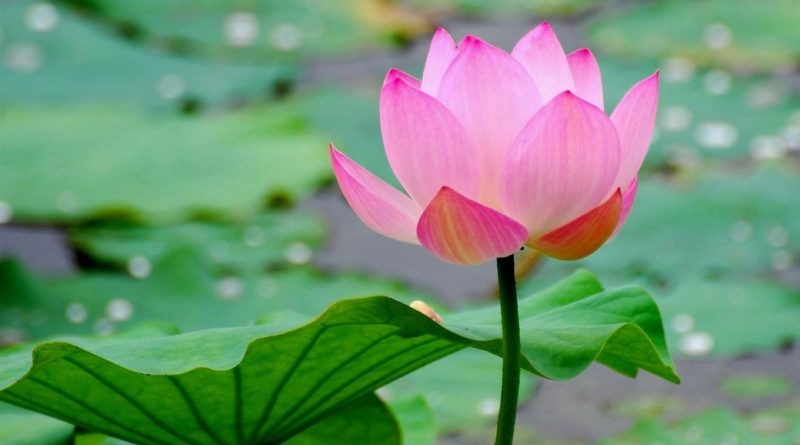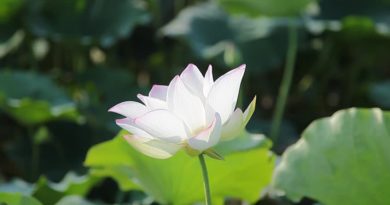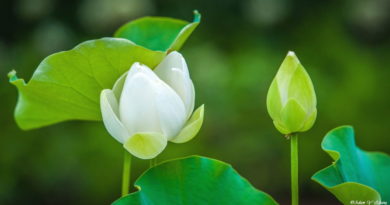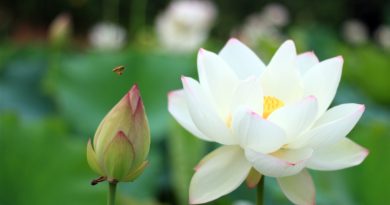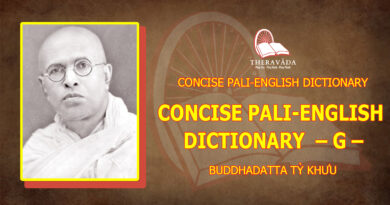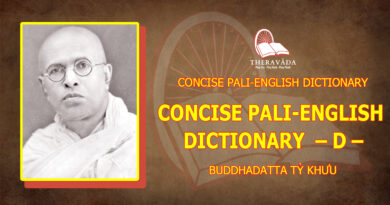Dissent And Protest In The Ancient Indian Buddhism – Chapter Vi: Conclusion (eng)
DISSENT AND PROTEST IN THE ANCIENT INDIAN BUDDHISM – CHAPTER VI: CONCLUSION
The heuristic method of criss-crossing that has been used in this Thesis involves roving between the so called orthodox and heresy in Ancient Buddhism. It requires a certain degree of neutrality from both sides. Does this mean that the writer is situated in a utopian space of objectivity, neutrally positioned above and beyond this subject? Is he a passive spectator with unobstructed vision of the Ancient Buddhism? Or is he a transparent specter in the reflecting mirrors of these subjects? While the metaphors of criss-crossing that have been used may suggest such a dislocated, disengaged perspective, these are not positions that I wish to assume or presume. Where then do I stand? To answer this question is not easy task, for it first requires performing an act of defamiliarization, through which one’s own existence becomes strange. Only then can one try to articulate one’s taken-for-granted attachments and one‘s complex relations to particular contexts of meaning. Recognizing that even this reflexive act of self-disclosure can be staged or exhibited, and that the gesture towards identifying my position will necessarily be inadequate, he will attempt nonetheless to locate his position within an intellectual and disciplinary context, and suggest some implications for this research.
As seen in the previous chapters, there are splits in Buddhism and it now seems that these splits go back much further than the traditional account of them. The tradition that went to western India and then down to the south of India had Pāli as its language, and it has an almost complete record. In the Northern tradition perhaps four-fifths of its documents have disappeared, but a very nearly complete record exists in Chinese translation. There are many contradictions between the southern tradition, which is comparatively well known, and the Northern tradition, which is now being studied extensively. Some of our ideas have not to be necessarily blown to pieces but revised in order to take account of new possibilities. Scholars tell us that we mustn’t bring our Western minds to bear on words such as ‘schism’ and ‘split’ and ‘heretic’. In the India of those days, these words didn’t have the meaning they have for us with our history of blood and burning alive. Chinese pilgrims report seeing Buddhist monks and Hindus walking together in processions. There has been very little of the furious hatred; and when something was accomplished by dubious means, the end was not thought to justify the means. For instance, in about 700 CE Shankara wished to enter into confrontation with one of the great Hindu ritualists of the time. He went to see him and he found Kumarila about to burn himself alive. Kumarila said, ‘Buddhists developed such strong logic that in order to meet them as a young man I disguised myself and entered the Buddhist Order to learn this logic. I did, and I have used it effectively. But for the sin of doing that, I am going to burn myself now. You have had your debate with my best pupil.’ And so they took the dhamma and its infringement very seriously. This was one of the reasons why the caste position was able to go on for so long, because there were these spectacular cases in which the representative of that caste was willing to sacrifice his life in a particularly difficult way in order to uphold the dhamma of his class.[1]
It is said that the Early Buddhism existed in the form of several fairly autonomous groups in India, partly due to the difficulties in communication amongst the groups at that time, and more importantly, due to the teaching from the last words of Sakyamuni Buddha.
In the Nirvāna Sūtra, Gotama Buddha asked the disciples to abide the Dharma, not to an individual person. He told the disciples that the precepts were their master after his death. So, I have already shown in the Second Chapter differences with his brother-in-law Devadatta who had not only tried to bring schism in the Saṁgha but also made an abortive attempt on Lord Buddha’s life, and a hundred years later, there have appeared subtle doctrinal and ritual differences among these various Buddhist groups.
Under the influence of the political and religious environment at that time, the elder Bhikkhus treated themselves as a highly disciplined class set apart from the lay community, carrying out special religious practice for the purpose of their own enlightenment. They emphasized the omnipotence of the rules of discipline that the precepts for the Order laid down by The Buddha should be abided by without the slightest deviation.
However, the Vajji Bhikkhus disputed and stressed the original intent of the teachings of Lord Buddha be allowed for all people in society (lay community), not just on one special class of people (monastic community). They argued that so long as there was no violation of the main tenets and precepts of Buddhism, it should be permitted to adapt to the socio-economical changes and the customs and practices of a specific region in which one was preaching or living to break the “obsolete” rules.
With the schism after the Second Council, the process of division continued until there were as many as eighteen sects, eleven of them belonging to the Sthavira and seven to the Mahāsaṁghika. Buddhism had entered a period of sectarianism.
From the historical point of view, the schism was an inevitable outcome in the development of Buddhism. On the surface, the Sthavira Bhikkhus would appear to be the upholders of orthodoxy and the Mahāsaṁghika Bhikkhus the heretics. In ordinary terms, the Sthavira seemed to be the dogmatists and the Mahāsaṁghika the revisionists.
The question of the greatest concern lies whether these sects preserved the true spirit of Sakyamuni Buddha’s teachings. In Buddhism, all reform movements have, as their starting point, the spirit of striving to return to the fundamentals of the faith and to restore the original meaning.
According to the Buddhist doctrine of Middle Way, any extreme is a deviant way to study Buddhism. A strong and healthy monastic order is necessary in Buddhism; however, if it is established on the basis of rejecting the lay community, it certainly violates the original meaning of Buddhism. On the other hand, a wide and popular support in lay community is necessary in Buddhism, however, if it is not led by the great masters who are enlightened by committing themselves in serious religious practices, it certainly deviates from the original meaning of Buddhism too.
The Buddha used to preach the Dhamma in different ways. He used to gauge the social, economical, political, and intellectual background and the capacity of the people before addressing them. Different standards in the rules of discipline are obviously required for different groups of people within the Buddha community. In different periods of time, one Buddhist Sect may be more appealing to the other. The existence of the development and the extinction of any Buddhist Sect had its conditions, in accordance with the Law of Causal Condition. Actually, the fate of Buddhism rests upon the ability to re-establish the fundamental principles of the doctrines, and to apply them correctly in practice.
The Dhammas expounded by any one sect is only one of many, many ways to attain Buddhahood. The ultimate truth i.e. the nature of Buddhist Dhamma is beyond thoughts and words, but can be experienced by self-certification. This is the profound doctrine of One Buddha Vehicle.
Bareau, in Les premiers conciles bouddhiques, comes almost to the same conclusion as presented above when he says, “One may justly think that the cause of the quarrel resided in the composition of the code of the monks and, more specifically, in the list of the siksakaranīya, Pāli: sikkhākaranīyā (precepts that should be observed),”[2] but he dismisses the conclusion immediately. “It is improbable that such a serious conflict could have been provoked by dissension on such a trivial subject.”[3] Yet Bareau also concedes that the majority of points for which the Vṛjiputraka bhikkhus were reproved were no more important than the ones cited here. I think that it is here that Bareau and others have missed an enormously valuable opportunity for understanding the growth of early Indian Buddhist sectarianism. I may never know with absolute certainty whether the rules cited above were precisely the rules to which the Śāriputtaparipṛcchā sutta alludes. Nonetheless, a comparison of the Pāli precepts in question with the extant Vinaya texts of other early Buddhist Nikāyas suggests a high degree of correlation.[4] This is especially significant since the non-Mahāsaṁghika nikāyas all emerged from a common basis in the original Sthavira trunk group. Further, as the Sthavira trunk subdivided internally over the next several centuries into many other nikāyas, each sect sought to underscore its own position with regard to personal and institutional conduct (and especially with regard to the geographic, communal circumstance in which it found itself) by appending additional rules in the Śaiksa‑dhamma section of its Prātimoksā‑sutra. (Pātimokkha-sutta)
As a result, I find 96 rules in the Chinese version of the Kāsyapīya text, 100 rules in the Chinese version of the Mahīsāsaka text, 100 rules in the Chinese Dhammaguptaka text, 108 rules in the Sanskrit and Tibetan Mūlasarvātivādin texts, and 113 rules in the Sanskrit and Chinese Sarvāstivādin texts. For this reason, the nikāyas became distinct not only by the doctrines they espoused, but by their rules for communal dwelling and behaviour. In some cases, these differences are of monumental importance. The Dhammaguptaka text, for example, advances twenty‑six rules in this section to delegate appropriate conduct at a stūpa. Apart from what this tells me, historically, about the Dhammaguptaka School, it offers significant insight into the ritual applications of Dhammaguptaka doctrinal affinities. In the light of the work by Hirakawa and Williams on the role of stūpa worship in the rise of Mahāyāna, this Vinaya material is critically important.[5]
Re-examination of the relationship of the ‘Orthodox’ and ‘Heresy’ has implications in the field of Buddhist studies. I have taken this task out of need to trespass upon the circumscribed disciplinary boundaries of Buddhist Studies. I do not conclude that orthodox which is a form of Early Buddhism and unorthodox is the Developed Buddhism in which the dissenter and protester emerged as an accuser. If I take serious look at Early Buddhism and Developed Buddhism as mutually constitutive, then the object of dissenter and protester need to be defined differentially, and refined never found or solidly founded. It invites more and more serious researched works. And the aim of this Thesis may be considered as the start, but not as an end of this endeavor.
-ooOoo-
BIBLIOGRAPHY
- ORIGINAL SOURCES:
- Anguttara Nikāya,Morris, R., and Hardy. E. Ed. 5Vols., London: P.T.S.,1885‑1990, F.L Woodward Tr. the Gradual Sayings, London: P.T.S.,1989.
- Dīgha Nikāya, Rhys Davids, T.W., and Carpenter, J.E. ed. 3 vols: London: P.T.S., 1890‑1911. Maurice Washshe Tr. The long Discourses, London: Wisdom Publication, 1987.
- Dhammapada, ed. V.Fausboll, London, Luzac, 1900
- Khuddaka Nikāya,Tucei, G. Ed. 15 vols., London: P.T.S., Bhikkhu Nana Moli., Tr. The Minor Readings, London. P.T.S., 1991.
- Majjhima Nikāya,Trenckner, V., Chalmers, and Mrs. Rhys Davids, Ed. 4 Vols. London: P.T.S., 1888‑1925. Horner, I.B. Tr. The Middle Length Sayings, London P.T.S., 1987.
- Mahāparinibbāna Sutta, PTS, London, 1908.
- Saṁyutta Nikāya,Fcer, M.L. Ed. 5Vols, London: P.T.S., 1984‑1925. Mrs. Rhys Davids and D.L. Woodward Tr. the Kindred Sayings, London: P.T.S., 1899.
- Sutta-piṭaka(except Jātaka) and Abhidhamma have been issused in separate volumes by Pāli Text Society, Oxford University Press, between 1882-1925
- Vinaya Piṭaka,Oldenberg, Ed. 5 Vols. London: P.T.S., 1979‑1883. Horner, I.B. Tr. The Book of the Discipline, London: P.T.S., 1992‑1993.
Translations:
- Abhidhamma Literature of the Sarvātivādins, J.Takakusu, PTS. 1904-5
- Book of the Discipline, Tr. I.B. Horner, Vol. V. London, Luzac & Co, 1952.
- Book of the Kindred Sayings, Tr. Mrs Rhys Davids. & F.L. Woodword, Pts. I-V, PTS, London 1971-75
- Cūlavagga,S.B.E., tr. By Horner.
- Dīgha Nikāyain Auswahl Uersetzt Von R.O. Franke, Gottingen, 1913
- Dialogues of the Buddhatr. By T.W. Rhys Davids (Dīgha-Nikāya) 3 vols, London, 1899-1921.
- Dīpavaṁsa, Tr. By H. Oldenberg, Edinburgh, 1879
- Futher Dialogues of the Buddhatranslated from the Pāli of the Majjhima Nikāya by Lord Chalmers, 2 vols, Oxford, 1926-7
- 9. Jātaka Taleswith introduction and notes by H.T. Francis and E.J. Thomas. Cambridge 1916 (Contains translations of 114 tales)
- Khuddhaka Pāṭha, tr. R.C. Childers. Tr. 1870
- Kathāvatthu, ed. Anold, c. Taylor, Vols. I&II, PTS, London, 1962-64
- Mahāvaṁsa,(or Great Chronicle of Ceylon) Tr. By W. Geiger, PTS, London, 1957.
- Mahāvagga(Vinaya Piṭaka) tr. H. Oldenberg, Vol.I, PTS, London, 1930
- Milindapañhā, ed. V. Trenckuer, London PTS, 1962
- Pāli literature in Ceylon,G.P. Malalasekera, London, 1928
- Pāli literature in Burma,M.H. Bode, London, 1909
- Saddhammapundarika Sūtra. St. Perterberg 1912 Tr. By Kern. In SBE; and by Burnouf asLe Lotus de La Bone Loi. Paris. 1852
- Saddhammapundarīka Sūtra, ed. H.Kern and Nanjio, St. Petersburg: The Imperial Academy of Sciences, 1912.
- The Mahāvaṁsa, from the thirty-seventh chapter, edicted by H. Sumangala and Don. A. De. Silva Butuvuantudewa. Columbo, 1877
- The Dhammapada, translated from the original Pāli Text of the Dhammapada commentary by E.W. Burlingame, 3vols, Cambridge, Mass, 1921, Havard of Ser. 28-30
- TheAnguttara Nikāya, tr. By E.R.J. Gooneratne (Eka-tika Nipāta. All published) Galle, Ceylon, 1918
- The Book of the Kindred sayings(Saṁyutta Nikāya) tr. By Mrs Rhys Davids, 5 vols, London, 1918
- The Jātaka, Tr. Under the editorship of E.B.Cowell. 6vols, Cambridge 1895-1913 (complete except for the Nidānakathā which is translated in Buddhist Birth Stories)
- The Jātaka together with its commentary, ed. By V.Fausbol, 6 volumes, London 1977-97
- Travels of Fah-Hien and Hsuan-Chuang, Bud. Pilgrims from China to India (400A.D. and 513 A.D) Tr. By S. Beal 1869
- The Mahāvaṁsoin Roman chareedes with the translation subjoined and an introductory on Pāli Buddhistical Literature, by. G.Tiennour. Vol. 1. Ceylon, 1837
- 27. Vinaya Texts, translated from the Pāli by T.W. Rhys Davids and H. Oldenberg (Pātimokkha, Mahāvagga, Cūlavagga) 3 vols. Oxford, 1881-5
- SECONDARY SOURCES:
- Andre Bareau,Les Primiers Conciles Bouddhiques, Pari, Press, University De France, 1955.
- Andre Bareau,Etude du Bouddhisme, Annuaire du College de France, 1988-89
- Allachin, Bridget and Raymond,The Birth of Indian Civilization. Varanasi, 1968
- A.S. Altekar,Education in Ancient India, Varanasi, 1957
- A.S. Altekar, Position of Women in Hindu Civilization, Banaras 1938
- A.M. Hocart,Buddha and Devadatta, Indian Antiquary, Vol.52, Oct. 1923, and vol. 54, Oct. 1925
- A.M. Shastri,An Outline of Early Buddhism, Varanasi, India, 1965
- A.K. Narain,Study in the History of Buddhism, New Delhi, 1980
- Anil Goonewardene,The Concept of The Buddha, Journal of the Buddhist Society.
- Arthur Waley, “New light on Buddhism in Mediaeval India”: Melanges chinois et bouddhiques, Vol. I, 1931-32
- Akira Hirakawa,A History of Indian Buddhism – From Sakyamuni to Early Mahāyāna Buddhism, tr. And ed. By Paul Groner, Motilal Banarsidass Publishers, Delhi 1998
- Akira Hirakawa,The Rise of Mahāyāna Buddhism and Its Relationship to the Worship of Stūpas,Memoirs of the Toyo Bunkyo Research Department 22, 1963.
- A. Hirakawa,A Study of the Vinaya Piṭaka, Tokyo, 1960
- B.M. Barua,Inscriptions of Asoka, Calcutta, 1934
- B.M. Barua,Asoka and His inscriptions, Calcutta, 1952
- B.R. Ambedkar,The Buddha and his Dhamma, Bombay, 1974
- B.G. Gokhale,New Light On Early Buddhism, Popular Prakashan Pvt. Ltd, 2001
- Bimala Churn Law,Geography of Early Buddhism, Oriental Books,
New Delhi, Second edition, 1979.
- Bharatiya Vidyabhavan,History and Culture of the IndianPeople, Vol III, Bombay, 1954.
- Biswadeb Mukherjee,The Schismatic Matters and the Early Buddhist Literature, Journal of Research V.B.Vol.1, part I, Humanities and Social Sciences, 1977.
- Biswadeb Mukherjee,Die Uberlieferung von Devadatta dem Widersacher des Buddha, in Den Kanosishchen Schriften, Munich, 1966.
- B.N.S. Yadava, Society and Culture in Northern India, Allahabad, 1973
- B.L Suzuki,Outlines of Mahāyana Buddhism, London, 1932.
- Cosma De Koros, Alexander,The Life and Teachings of Buddha, Calcutta, 1957.
- C. W. Fu, and S. A. Wawrytko, eds.Buddhist Ethics and Modern Society: an International Symposium. New York: Greenwood Press. 1991
- C. S. Prebish, ed.Buddhist Ethics: A Cross-cultural Approach. Kendall; Hunt, 1992.
- Charles S. Prebish, Buddhist Monastic Discipline: The Sanskrit Prātimoksa Sūtras of the Mahāsāṁghika and Mūlasarvādins, University Park, Pennsylvania State University Press, 1975
- Charles S. Prebish and Janice J. Nattier,Māsāṁghika Origin – The Beginning of Sectarianism,History of Religions 16, February 1977
- David McMahan, Orality,Writing, And Authority in South Asian Buddhism. History of Religion.
- D. Devahuti, Harsha:A Political Study. Oxford University Press, Delhi 1999
- D.C Sircar, (ed).Social Life in Ancient India. Calcutta, 1971.
- D. Keown,Contemporary Buddhist Ethics. London: Curzon Press, 2000.
- D. Keown,The Nature of Buddhist Ethics. London: Macmillan, 1992.
- D. Keown,Buddhism and Bioethics. London: Macmillan; New York: St. Martin’s Press, chap. 1, 1995.
- Etienne Lamotte,History of Indian Buddhism, Tr. From French by Sara Webb.Boin. Universite’ Catholique de Louvain, Institute Orientaliste, 1988
- E. Lamotte,Le Bouddha insulta-t-il Devadatta, BSOAS, 33-1970
- Edward J. Thomas,The Life of Buddha as Legend and History, 3e, London, 1949
- E.Conze,Buddhist Thought in India, London, 1962
- Edouard Chavannes, Memoire compose a l’ dpoque de la grande dynastie T’ang sur les Religieux Eminents qui allerent chercher la loi dans les pays d’ Occident, par I-tsing, Paris, 1894.
- E. J. Harris,What Buddhists Believe. Oxford: Oneworld. 1998
- F.L. Woodward, Tr. The Minor Anthologies of The Pāli Canon, 2: Udāna. Verses of Uplift and Itivuttaka. As It Was Said, London, 1935.
- G.B. Upreti, The Early Buddhist World Outlook in Historical Perspective, Manohar, 1997
- G. S. P. Misra, 1984.Development of Buddhist Ethics. New Delhi: Munshiram Manoharlal, 1984.
- G. Dhammasiri,Fundamentals of Buddhist Ethics. Antioch, Ca. Golden Leaves Publ. Co.1989.
- Hazra, Kanailal,Royal Patronage of Buddhism in Ancient India, New Delhi, 1984
- Har Dayal,The Boddhisattva Doctrine.Motilal, Delhi, 1992.
- Hazra, Kanailal, Royal Patronage of Buddhism in Ancient India. New Delhi, 1984.
- HarDer,The Early Buddhist Theory of Man Perfected, London, 1936.
- Hermann Oldenberg,Buddhist Suttas, S.B.E., XI, Introduction to the Buddhist Suttas, Journal of Pāli Texts Society, 1881.
- H. Oldenberg,Buddha-His Life-His Doctrines-His Order,Motilal, Delhi, 1996
- Finot,Indian Historical Quarterly, chapter of Finot, (Journal) Calcutta, 1941
- I.B. Horner,The Early Buddhist Theory of Man Perfected, London, 1936
- J.C. Holt,Discipline: The Canonical Buddhist of the Vinayapiṭaka, Delhi, Motilal Banarsidass, 1981.
- John Powers and James Fieser,Anthology of Sciptures of World Religions, to be published by McGraw-Hill Publications in 1997
- K.W. Morgan,The Path of The Buddha, NewYork, 1956
- Kalipadamitra,Cross-Cousin Relation between Buddha and Devadatta, 1976
- K. Kraft,Inner Peace, World Peace: Essays on Buddhism and Nonviolence, Albany, N.Y. State University of New York Press, 1992.
- K.T.S. Sarao,Origine and Nature Ancient Indian Buddhism, R&R Publishers, Delhi, 1999
- Louis De La Poussin,The Buddhist Councils, Calcutta, 1976
- L. S. Cousins,Good or Skilful?Kusala in Canon and Commentary. Journal of Buddhist Ethics 3:136–64. 1996
- L. S. Cousins,Ethical Standards in World Religions: III.Buddhism. The Expository Times Vol. LXXXV, 1974.
- N. Eliade,Early Monastic Buddhism, Second edition, Calcutta Firma K.L. Mukhopadhyay, 1971
- Nalinaksha Dutt,Early Monastic Buddhism, Calcutta, 1941
- Nalinaksha Dutt,Buddhist Sects In India, Motilal Banarsidass, Delhi 1998.
- N.Dutt,Mahāyāna Buddhism, Calcutta, 1973
- N.K. Dutt,Origin and Growth of Caste in India, Calcutta, 1965
- N. Katz, Buddhist Images of Human Perfection: the Arahant of the Sutta Piṭaka Compared with the Bodhisattva and Mahāsiddha. Delhi: Mtilal Banarsidass, 1982.
- Paul Williams,Mahāyāna Buddhism: The Doctrinal Foundations, London: Routledge, 1989.
- Peter Harvey,An Introduction to Buddhism,Teachings, History and Practices, Cambridge University Press, reprinted 2000.
- P. Harvey,Criteria for judging the unwholesomeness of actions in the texts of Theravāda Buddhism. Journal of Buddhist Ethics 2:140–151. 1995.
- P.Harvey, An Introduction to Buddhist Ethics: Foundations, Values and Issues. Cambridge: Cambridge University Press, 2000.
- P. Lakshmi Narasu,The Essence of Buddhism, Delhi 1976
- R. Fick,The Organization in NorthEast India in Buddha’s Time, 1999
- R.C. Mitra,The Decline of Buddhism In India, Vishva Bharati Studies, 1954
- R. Kimura,Hinayāna and Mahāyāna and the Origine of Mahāyāna Buddhism, Calcutta, 1925
- R.C. Dutt,Buddhism and Buddhist Civilization in India. Lucknow, 1983
- R. Hinderey,Comparative Ethics in Hindu and Buddhist Traditions. Delhi: Motilal Banarsidass. 1978.
- R.S. Sharma,Material Culture and Social Formation in Ancient India, Delhi, 1993
- Sen, Madhu (ed),Studies in Religion and Change, New Delhi, 1993.
- S.N. Das Gupta,A history of Indian Philosophy, Cambridge University Press, 1932.
- S.R. Goyal,A History of Indian Buddhism,Kusumanjali Book World, Jodhpur, 2002.
- Su-yu-ki,Buddhist Records of the Western World(popular Edition), two volumes in one, Sammuel Beal, London, 1906.
- Stcherbatsky,The Central Concept Of Buddhism, London, 1922.
- Samuel Beal, (Tr.)The Travels of Fah-hian and Sung Yun, London, 1869
- Sumangal Barua,Buddhist Councils and Development of Buddhism, Atisha Memorial Publishing Society, Calcutta, July 1977.
- Trevor Leggett,The Buddhist Order after the Passing of the Buddha, Middle Way, Vol. 76: 2, August 2001,
- Trevor Leggett,Conditions in India after the Buddha, Middle Way. 2001.
- Trevor Leggett,Early Indian Buddhism, Volume 76: 4, February 2002.
- T. Watters,On Yuan Chwang’s Travels in India, 2 vols. London, 1945.
- V.P. Varnia,Modern Indian Political Thought, Agra, 1986.
- W.W. Rockhill,The Life of the Buddha and the Early History of His Order, London, 1884.
- Weber, Max.The Religion of India,Motilal, Delhi, 1987.
- Whitehill, James. “Buddhism and the Virtues” in Keown, (ed.) Contemporary Buddhist Ethics. London: Curzon Press, 17-36, 2000.
- W.H. MacGovern,An Introduction to Mahāyāna Buddhism, Calcutta, 1925.
- DICTIONARIES, CATALOGUES AND ENCYCLOPAEDIAS:
- C.S. Upasak,Dictionary of Early Buddhist Monastic terms, Varanasi, Sharati Prakashan, 1973.
- Bunyiu Nanyo,A catalogue of the Buddhist Tripiṭaka, the Sacred Canon of the Buddhists in China and Japan, Oxford, Clarendon Press, 1883.
- Franklin Edgerton,Buddhist Hybrid Sanskrit Dictionary, Vol.II, Delhi, Motilal, Banarsidass, 1972.
- G.P. Malalasekara,Dictionary of Pāli Proper Name, 2vols. London, 1937-38
- G.P. Malalasekera,Encyclopaedia of Buddhism,vl.III. Published by the Government of Ceylon, 1971
- James Hastings (ed.)Encyclopaedia of Religion and Ethics, Vols. IV. VI & X. Edinburg, T&T Clark, 1935
- Mircea Eliade,Encyclopaedia of Religions, 1979
- R.C. Childers,Dictionary of the Pāli language, Kyoto, Japan, Rinsen Book Company 1976.
- S.G.E. Brandon. (ed.)A dictionary of compare Religion, Brandon, London, Weidenfeld & Nicolson, 1970.
- T.W. Rhys Davids & William Stede,Pāli-English Dictionary, New Delhi, Oriental Book reprint, 1975.
- JOURNALS AND PERIODICALS:
- Hindustan Times, New Delhi.
- Journal of American Academy of Religion.
- Journal of Asian and African Studies
- Journal of the Buddhist Society.
- Journal of the Bombay Branch of Association Society
- Journal of the Benaras Hindu University
- Journal of the Bihar Research Society, Patna
- Journal of the Department letters Calcutta University.
- The Mahabodhi, Calcutta.
- Journal of the international Association of Buddhist Studies
- Journal of Oriental institute of Baroda
- Journal of the proceedings of the Association Society of Bengal
- Journal of the Pāli Text Society. London.
- Istituto Italiano per it Medio ed. Estremo Oriente, Rome.
-ooOoo-
[1]. Early Indian Buddhism, Trevor Leggett, volume 76:4, February 2002, p.205
[2]. Les premiers conciles bouddhiques, Bareau, p. 94.
[3]. Ibid .
[4]. Here one should refer to the Sanskrit and Chinese texts of the Sarvāstivādin nikāya, the Sanskrit and Tibetan versions of the Mūllasarvāstivādin text, the Dharmaguptaka, Mahīsāsaka, and Kāsyapiya texts preserved in Chinese.
[5]. The Rise of Mahāyana Buddhism and Its Relationship to the Worship of Stūpas, Akira Hirakawa, Memoirs of the Toyo Bunkyo Research Department 22, 1963, p. 57‑106; Paul Williams, Mahāyāna Buddhism: The Doctrinal Foundations, London: Routledge, 1989, pp. 20‑33

